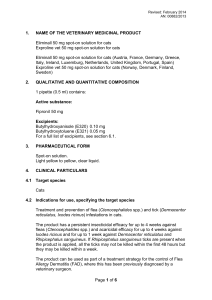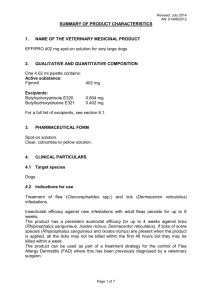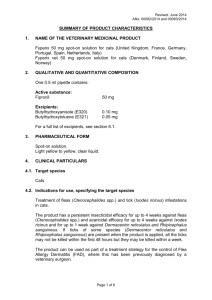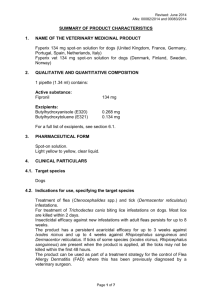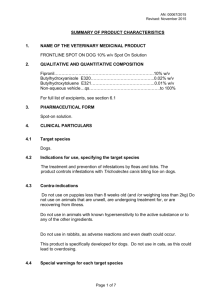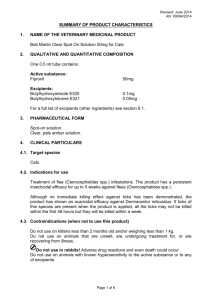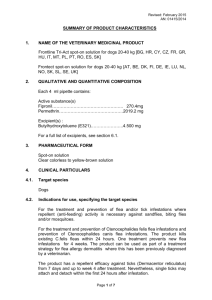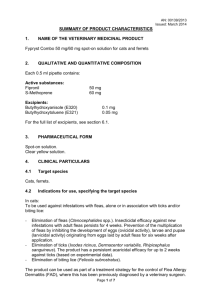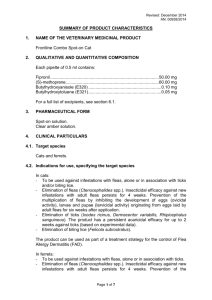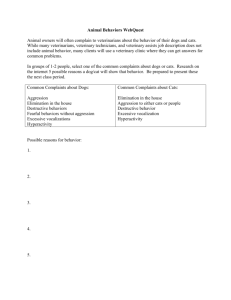Revised: July 2015 AN: 00383/2015 SUMMARY OF PRODUCT
advertisement
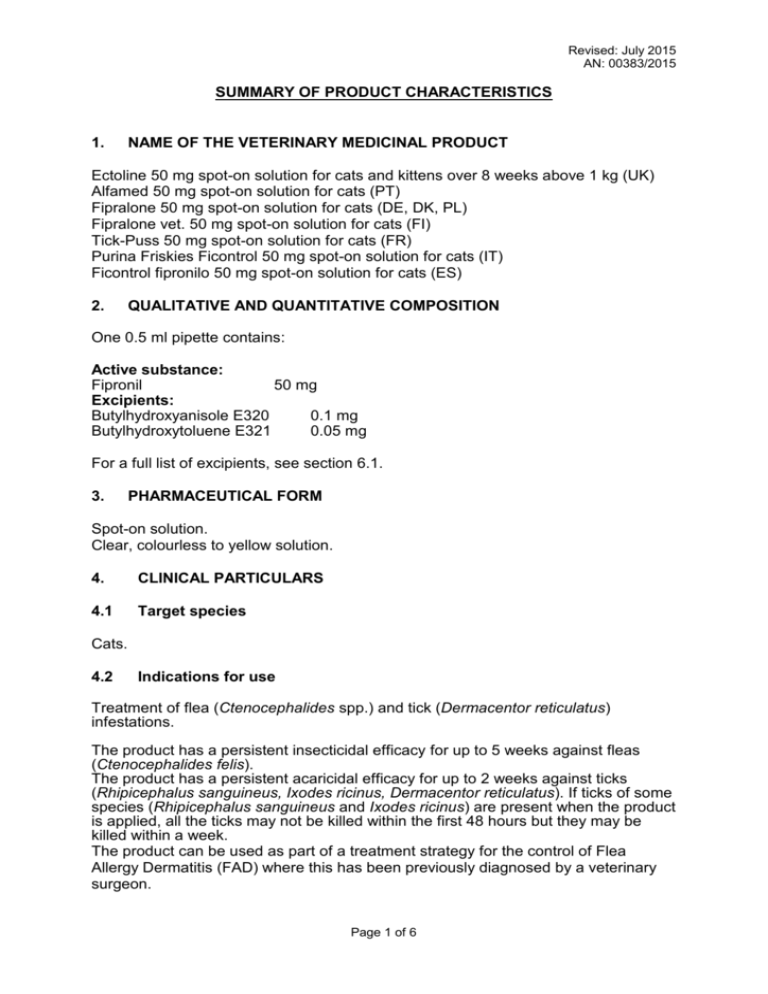
Revised: July 2015 AN: 00383/2015 SUMMARY OF PRODUCT CHARACTERISTICS 1. NAME OF THE VETERINARY MEDICINAL PRODUCT Ectoline 50 mg spot-on solution for cats and kittens over 8 weeks above 1 kg (UK) Alfamed 50 mg spot-on solution for cats (PT) Fipralone 50 mg spot-on solution for cats (DE, DK, PL) Fipralone vet. 50 mg spot-on solution for cats (FI) Tick-Puss 50 mg spot-on solution for cats (FR) Purina Friskies Ficontrol 50 mg spot-on solution for cats (IT) Ficontrol fipronilo 50 mg spot-on solution for cats (ES) 2. QUALITATIVE AND QUANTITATIVE COMPOSITION One 0.5 ml pipette contains: Active substance: Fipronil 50 mg Excipients: Butylhydroxyanisole E320 0.1 mg Butylhydroxytoluene E321 0.05 mg For a full list of excipients, see section 6.1. 3. PHARMACEUTICAL FORM Spot-on solution. Clear, colourless to yellow solution. 4. CLINICAL PARTICULARS 4.1 Target species Cats. 4.2 Indications for use Treatment of flea (Ctenocephalides spp.) and tick (Dermacentor reticulatus) infestations. The product has a persistent insecticidal efficacy for up to 5 weeks against fleas (Ctenocephalides felis). The product has a persistent acaricidal efficacy for up to 2 weeks against ticks (Rhipicephalus sanguineus, Ixodes ricinus, Dermacentor reticulatus). If ticks of some species (Rhipicephalus sanguineus and Ixodes ricinus) are present when the product is applied, all the ticks may not be killed within the first 48 hours but they may be killed within a week. The product can be used as part of a treatment strategy for the control of Flea Allergy Dermatitis (FAD) where this has been previously diagnosed by a veterinary surgeon. Page 1 of 6 Revised: July 2015 AN: 00383/2015 4.3 Contraindications In the absence of available data, the product should not be used on kittens less than 2 months old and/or weighing less than 1 kg. Do not use on sick (systemic diseases, fever…) or convalescent animals. Do not use in rabbits, as adverse drug reactions and even death could occur. Do not use in cases of hypersensitivity to the active substance or to any of excipients. 4.4 Special warnings for each target species Fleas from pets often infest the animal's basket, bedding and regular resting areas such as carpets and soft furnishings which should be treated, in case of massive infestation and at the beginning of the control measures, with a suitable insecticide and vacuumed regularly. The product does not prevent ticks from attaching to the animals. If the animal has been treated prior to exposure to the ticks, the ticks will be killed in the first 24-48 hours after attachment. This will usually be prior to engorgement, minimising but not excluding the risk of transmission of diseases. Once dead, ticks will often drop off the animal, but any remaining ticks may be removed with a gentle pull. It is advisable to avoid frequent bathing or shampooing because the maintenance of effectiveness of the product in these cases has not been tested. When used as part of a strategy for the treatment of Flea Allergy Dermatitis, monthly applications to the allergic patient and to other cats in the household are recommended. For optimum control of flea problems in a multi-pet household, all dogs and cats in the household should be treated with a suitable insecticide. 4.5 Special precautions for use Special precautions for use in animals Avoid contact with the animal’s eyes. In the case of accidental eye contact, immediately and thoroughly flush the eyes with water. Do not apply the product on wounds or damaged skin. Special precautions to be taken by the person administering the veterinary medicinal product to animals This product can cause mucous membrane and eye irritation. Therefore, contact between the product and the mouth or eyes should be avoided. In the case of accidental eye contact, immediately and thoroughly flush the eyes with water. If eye irritation persists seek medical advice and show the package leaflet or the label to the physician. Avoid contents coming into contact with the fingers. If this occurs, wash hands with soap and water. Wash hands after use. Do not smoke, drink or eat during application. Page 2 of 6 Revised: July 2015 AN: 00383/2015 People with known hypersensitivity to fipronil or excipients should avoid contact with the veterinary medicinal product. Treated animals should not be handled until the application site is dry, and children should not be allowed to play with treated animals until the application site is dry. It is therefore recommended that animals are not treated during the day, but should be treated during the early evening, and that recently treated animals should not be allowed to sleep with owners, especially children. Other precautions The alcohol carrier may have adverse effects on painted, varnished or other household surfaces or furnishings. 4.6 Adverse reactions (frequency and seriousness) If licking occurs, a brief period of hypersalivation may be observed due mainly to the nature of the carrier. Among the extremely rare suspected adverse reactions, transient cutaneous reactions at the application site (squamosis, local alopecia, pruritus, erythema) and general pruritus or alopecia have been reported after use. Exceptionally, hypersalivation, reversible neurologic symptoms (hyperesthesia, depression, nervous symptoms) or vomiting have been observed after use. 4.7 Use during pregnancy and lactation Laboratory studies using fipronil have not shown any evidence of teratogenic or embryotoxic effects. Studies have not been carried out with this product in pregnant and lactating queens. Use in pregnancy and lactation only in accordance with professional veterinary advice and a benefit/risk assessment. 4.8 Interaction with other medicinal products and other forms of interaction None known. 4.9 Amounts to be administered and administration route Route of administration and dosage: External use only. Administer by topical application to the skin 1 pipette of 0.5 ml per animal. Method of administration: Thermoformed pipettes: Hold the pipette upright. Tap the narrow part of the pipette to ensure that the contents are within the main body of the pipette. Break the snap-off top of the spoton pipette along the scored line. Part the pet’s coat until its skin is visible. Place the tip of the pipette directly against the bared skin and squeeze gently several times to empty its contents Repeat this procedure at one or two different points along the cat’s back, preferably at the base of the head and between the shoulders. Page 3 of 6 Revised: July 2015 AN: 00383/2015 Polypropylene pipettes: Remove the pipette from the blister packaging. Hold the pipette in an upright position, twist and pull the cap off. Turn the cap around and place the other end of the cap back on the pipette. Twist the cap to break the seal, then remove the cap from the pipette. Part the pet’s coat until its skin is visible. Place the tip of the pipette directly against the bared skin and squeeze gently several times to empty its contents. Repeat this procedure at one or two points along the cat’s back, preferably at the base of the head and between the shoulders. It is important to make sure that the product is applied to an area where the animal cannot lick it off, and to make sure that animals do not lick each other following treatment. Care should be taken to avoid excessive wetting of the hair with the product since this will cause a sticky appearance of hairs at the treatment spot. However, should this occur, it will disappear within 24 hours post application. White deposits may also be seen at the site for up to 48 hours after application. Treatment schedule: For optimal control of flea and/or tick infestation the treatment schedule can be based on the local epidemiological situation. In the absence of safety studies, the minimum treatment interval is 4 weeks. 4.10 Overdose (symptoms, emergency procedures, antidotes), if necessary No adverse effects were observed in target animal safety studies in cats and kittens aged 2 months and older and weighing about 1 kg treated at five times the recommended dose (daily therapeutic dose applied on five consecutive days) for three consecutive months except for itching and vomiting that occurred once. The risk of adverse effects may increase in cases of over-dose. 4.11 Withdrawal period Not applicable. Page 4 of 6 Revised: July 2015 AN: 00383/2015 5. PHARMACOLOGICAL PROPERTIES Pharmacotherapeutic group: Ectoparasiticides for topical use. ATCvet code: QP53AX15 5.1 Pharmacodynamic properties Fipronil is an insecticide and acaricide belonging to the phenylpyrazole family. It acts by inhibiting the GABA complex, binding to the chloride channel and thereby blocking pre- and post-synaptic transfer of chloride ions across cell membranes. This results in uncontrolled activity of the central nervous system and death of insects or acarids. Fipronil exhibits an insecticidal and acaricidal activity against fleas (Ctenocephalides spp) and ticks (Rhipicephalus spp, Dermacentor spp, Ixodes spp. including Ixodes ricinus) in the cat. Fleas will be killed within 24 h. Ticks will usually be killed within 48 h after contact with Fipronil, however if ticks of some species (Rhipicephalus sanguineus and Ixodes ricinus) are present when the product is applied, all the ticks may not be killed within the first 48 hours. 5.2 Pharmacokinetic particulars In vitro, fipronil is mainly metabolised with subcellular liver fractions to its sulfone derivative. However, this may be of limited relevance ‘in vivo’ as fipronil is poorly absorbed in the cat. The concentrations of fipronil on the hair decrease with time. 6. PHARMACEUTICAL PARTICULARS 6.1 List of excipients Butylhydroxyanisole E320 Butylhydroxytoluene E321 Benzyl alcohol Diethylene glycol monoethyl ether 6.2 Incompatibilities None known. 6.3 Shelf life Shelf-life of the veterinary medicinal product as packaged for sale : 2 years. 6.4. Special precautions for storage Store below 30C. Store in a dry place. Store in the original package. Do not remove from blister until required for use. 6.5 Nature and composition of immediate packaging Thermoformed pipettes: White or transparent multi-layer plastic single-dose pipette containing an extractible volume of 0.5 ml. Page 5 of 6 Revised: July 2015 AN: 00383/2015 The internal layers in contact with the product are made of polyacrylonitrilemethacrylate. The white external complex is composed of polypropylene/ cyclic olefine copolymer/ polypropylene. Boxes of 1, 2, 3, 4, 6, 8, 12, 24, 30, 60, 90 or 150 pipettes. The boxes contain pipettes either with or without an individual blister for each pipette. Polypropylene pipettes: White polypropylene single-dose pipette containing an extractible volume of 0.5 ml packaged in uncoloured plastic blister composed of polypropylene/cyclic olefine copolymer / polypropylene closed by heat sealing with a thermosealable lacquered aluminium foil and placed in a carton box or blister card. Blister cards or boxes of 1, 2, 3, 4, 6, 8, 12, 24, 30, 60, 90 or 150 pipettes. Not all pack sizes may be marketed. 6.6 Special precautions for the disposal of unused veterinary medicinal product or waste materials derived from the use of such products Any unused veterinary medicinal product or waste materials derived from such veterinary medicinal products should be disposed of in accordance with local requirements. The product should not enter water courses as this may be dangerous for fish or other aquatic organisms. Do not contaminate ponds, waterways or ditches with the product or empty container. 7. MARKETING AUTHORISATION HOLDER ALFAMED 13ème rue - L.I.D. 06517 Carros Cedex France 8. MARKETING AUTHORISATION NUMBER Vm 17902/4015 9. DATE OF FIRST AUTHORISATION 16 April 2009 10. DATE OF REVISION OF THE TEXT July 2015 Page 6 of 6
